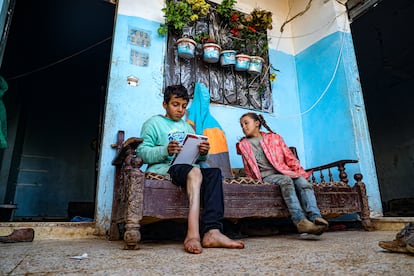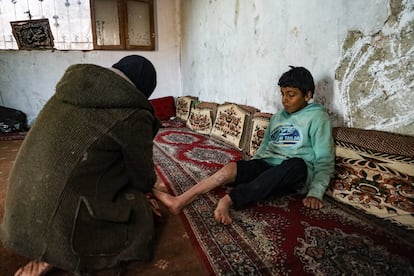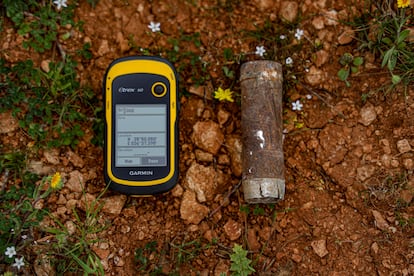Unexploded cluster bombs. The deadly legacy that continues to threaten Syrians
Specialist munitions clearance teams seek and destroy explosives that failed to detonate, which were launched by the Assad regime and Russia, according to international organizations

It is a Sunday morning in March and the team of Maamoun al Omar, head of the War Remnants Disposal Center of the Syrian Civil Defense (White Helmets) in the town of Ariha in northern Syria, has just received a call from a man reporting of the presence of a strange object in a residential area of Al Nayrab. The team heads to the location and cordons off the area to prevent civilians from entering. With extreme caution, they approach and photograph the object.
The Civil Defense Center confirms that it is an explosive. Two women surround him with bags of earth and spray him with a substance to cause a controlled detonation. Al Omar suspects that the explosive was a cluster bomb, although a report must still confirm this. “Not a month goes by without us destroying between six and ten bombs of this type,” says Al Omar.
The Assad regime in Syria and its Russian ally have launched missiles loaded with cluster bombs on the northern regions of the country since 2011, according to various international organizations. These weapons contain dozens of explosive bomblets that are scattered when they reach their target. However, approximately a third of them do not explode on impact, although they remain active and represent an enormous risk to the public, since they can still explode if they are disturbed. A total of 124 countries have acceded to the Convention on Cluster Munitions, which “prohibits all use, production, transfer, and storage” of this type of explosive. Non-signatory countries include the United States, which used these weapons in Iraq, and Russia, which has dropped them on Ukraine and Syria.
It was one of these bombs that injured Abdul Rahman al Safar. He looks sad as he says quietly: “I thought it was a ball. But when I threw it to the ground, it exploded on my leg and I felt pain.” He was four years old when a cluster bomb destroyed his right foot.
The accident occurred when he returned home in 2020. A year earlier, the attacks in the north of the country by Bashar al-Assad’s regime had forced the eight members of the Al Safar family to leave their home. When they returned, they found the house full of weeds and war debris. One day, Abdul Rahman was playing in the grass and found a red ribbon tied to an artifact and picked it up. “I heard an explosion and I started running,” 42-year-old Maryam Matr, the little boy’s mother recalls. “We immediately took him to the hospital,” she tells this newspaper in an interview from her home.
Matr says that her grandmother Hassana al Satouf also died in a similar incident from a cluster bomb explosion in 2019. “We had never seen these explosives before in our lives and we didn’t know what they look like. “My husband has found several in different places,” she says.
“This type of bomb is a piercing weapon that causes very serious injuries,” explains Al Omar. In addition, some, like the M77, have a white or red ribbon that “catches the attention especially of young children, who think it is a toy. But when they touch it or move it, it explodes,” the man warns.

14-year-old Mustafa Muhanna Sukhouri, and his 16-year-old brother Abdullah are neighbors of Abdul Rahman al Safar. They were also injured by shrapnel all over their bodies when a cluster bomb they found on the land next to them exploded. “We thought it was a toy and started to dismantle it. My brother threw it against a rock and it exploded on impact. Our neighbor was near us and took us to the hospital,” says Mustafa.
Since the war broke out in 2011, the Syrian regime, supported by Russia, has used more than a dozen models of cluster bombs, according to the Syrian Network for Human Rights. Between 2011 and April 2023 the organization documented the deaths of 2,971 civilians, including 765 children and 304 women, as a result of landmine explosions. In addition, 382 civilians, including 124 children and 31 women, lost their lives as a result of exploding cluster munition debris — more than 600,000 people have died in the Syrian war since the conflict began, according to the Syrian Observatory for Human Rights. As of 2021, Syria was the country with the highest number of cluster munition casualties in the world, a position now led by Ukraine, according to the report by the Cluster Munition Coalition and the International Campaign to Ban Landmines (ICBL-CMC).
The types of cluster munitions that Al Omar says they frequently encounter are ShOAB-0.5 and AO-2.5RT/RTM. They are the same weapons mentioned in a Human Rights Watch report which states that Syria and Russia have used them on a large scale in their attacks. “We are intensifying awareness sessions on war remnants in schools,” says the person in charge of weapons deactivation.
The Syrian Network for Human Rights also points directly to the Assad regime and Moscow in a report which states that most of the explosives were used in border areas, especially between Syria and Turkey. “We must continue working on eradicating them because they are a real danger,” says the organization’s director, Fadl Abdul Ghani, in an interview with this newspaper.

The artillery and aerial bombardments that continue to target the northwestern region of Syria from time to time may hamper operations to seek and destroy these munitions. “The solution is to stop the bombings against civilians completely and for specialist teams to begin removing these devices safely and on a large-scale. These bombings prevent us from visiting many areas and towns to work safely on clearing these explosives,” concludes Al Omar. “The situation is dangerous because we, in the Syrian network, are still registering injuries and deaths,” explains Ghani.
Reem Rahmoun knows the risk. The 26-year-old is one of the volunteers still working to defuse explosives. “We underwent high-precision training to learn about the types of remnants of war and unexploded ordnance and deal with them without harming ourselves or our colleagues,” says Rahmoun from Al Nayrab, the place where Al Omar’s team has managed to remove a potential explosive. Despite the danger, it pays off, because it makes him happy to “save lives.” There are no precise statistics available on victims of remnants of war and cluster munitions in Syria, but according to UN data, around 28% of the Syrian population over the age of two suffers from some form of disability as a result of the war.
Without proper treatment, the consequences of amputations and injuries worsen. Abdul Rahman is still suffering from the consequences of the explosion four years later. No organization funded his treatment, and the costs have become a burden on his family as he needs medication and moisturizers to repair his skin. Without resources, his mother can only cure him with olive oil. And the little boy, who before the explosion was a restless child who enjoyed playing, is now afraid of everything around him.
Sign up for our weekly newsletter to get more English-language news coverage from EL PAÍS USA Edition
Tu suscripción se está usando en otro dispositivo
¿Quieres añadir otro usuario a tu suscripción?
Si continúas leyendo en este dispositivo, no se podrá leer en el otro.
FlechaTu suscripción se está usando en otro dispositivo y solo puedes acceder a EL PAÍS desde un dispositivo a la vez.
Si quieres compartir tu cuenta, cambia tu suscripción a la modalidad Premium, así podrás añadir otro usuario. Cada uno accederá con su propia cuenta de email, lo que os permitirá personalizar vuestra experiencia en EL PAÍS.
¿Tienes una suscripción de empresa? Accede aquí para contratar más cuentas.
En el caso de no saber quién está usando tu cuenta, te recomendamos cambiar tu contraseña aquí.
Si decides continuar compartiendo tu cuenta, este mensaje se mostrará en tu dispositivo y en el de la otra persona que está usando tu cuenta de forma indefinida, afectando a tu experiencia de lectura. Puedes consultar aquí los términos y condiciones de la suscripción digital.
More information
Últimas noticias
The new victims of the Republican war on Obamacare: Millions hit by soaring health insurance premiums
A country divided on migrant rights: Some US states expand protections while others restrict them
Venezuela authorizes the release of another 87 political prisoners
There is as much life left to discover on planet Earth as that which is already known
Most viewed
- David King, chemist: ‘There are scientists studying how to cool the planet; nobody should stop these experiments from happening’
- Reinhard Genzel, Nobel laureate in physics: ‘One-minute videos will never give you the truth’
- Oona Chaplin: ‘I told James Cameron that I was living in a treehouse and starting a permaculture project with a friend’
- Sinaloa Cartel war is taking its toll on Los Chapitos
- The Interoceanic Train, the Mexican alternative to the Panama Canal









































